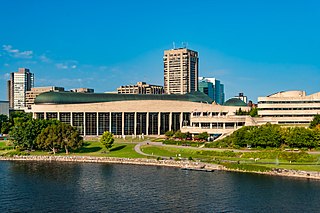
The Canadian Museum of History is a national museum on anthropology, Canadian history, cultural studies, and ethnology in Gatineau, Quebec, Canada. The purpose of the museum is to promote the heritage of Canada, as well as support related research. The museum is based in a 75,000-square-metre-building (810,000 sq ft) designed by Douglas Cardinal.

Pitt Rivers Museum is a museum displaying the archaeological and anthropological collections of the University of Oxford in England. The museum is located to the east of the Oxford University Museum of Natural History, and can only be accessed through that building.

The National Football Museum is England's national museum of football. It is based in the Urbis building in Manchester city centre, and preserves, conserves and displays important collections of football memorabilia.
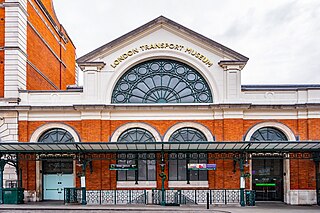
The London Transport Museum is a transport museum based in Covent Garden, London. The museum predominantly hosts exhibits relating to the heritage of London's transport, as well as conserving and explaining the history of it. The majority of the museum's exhibits originated in the collections of London Transport, but, since the creation of Transport for London (TfL) in 2000, the remit of the museum has expanded to cover all aspects of transportation in the city and in some instances beyond.

The Abraham Lincoln Presidential Library and Museum documents the life of the 16th U.S. president, Abraham Lincoln, and the course of the American Civil War. Combining traditional scholarship with 21st-century showmanship techniques, the museum ranks as one of the most visited presidential libraries. Its library, in addition to housing an extensive collection on Lincoln, also houses the collection of the Illinois State Historical Library, founded by the state in 1889. The library and museum is located in the state capital of Springfield, Illinois, and is overseen as an agency of state government. It is not affiliated with the U.S. National Archives and its system of libraries.
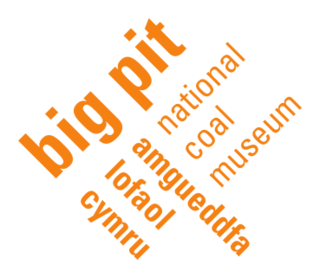
Big Pit National Coal Museum is an industrial heritage museum in Blaenavon, Torfaen, Wales. A working coal mine from 1880 to 1980, it was opened to the public in 1983 as a charitable trust called the Big Pit (Blaenavon) Trust. By 1 February 2001 Big Pit Coal Museum was incorporated into the National Museums and Galleries of Wales as the National Mining Museum of Wales. The site is dedicated to operational preservation of the Welsh heritage of coal mining, which took place during the Industrial Revolution.
Dŵr Cymru Welsh Water is a not-for-profit company which supplies drinking water and wastewater services to most of Wales and parts of western England that border Wales. In total, it serves around 1.4 million households and businesses and around three million people - and supplies nearly 830 million litres of drinking water per day.
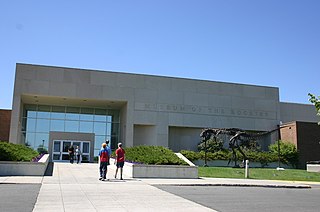
Museum of the Rockies is a museum in Bozeman, Montana. Originally affiliated with Montana State University in Bozeman, and now also, the Smithsonian Institution. The museum is largely known for its Paleontological collections as well as having the largest collection of North American Dinosaur fossils in the United States. They also possess the largest Tyrannosaurus skull ever discovered, as well as the thigh bone of a Tyrannosaurus Rex that contains soft-tissue remains. The museum is part of the Montana Dinosaur Trail and is Montana's official repository for Paleontological specimens.
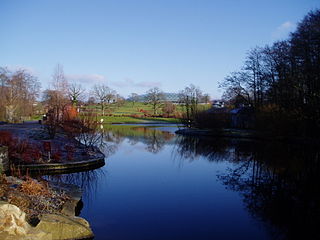
The National Botanic Garden of Wales is a botanical garden located in Llanarthney in the River Tywi valley, Carmarthenshire, Wales. The garden is both a visitor attraction and a centre for botanical research and conservation, and features the world's largest single-span glasshouse, measuring 110 m (360 ft) long by 60 m (200 ft) wide.

The Children's Museum of Indianapolis is the world's largest children's museum. It is located at 3000 North Meridian Street, Indianapolis, Indiana in the United Northwest Area neighborhood of the city. The museum is accredited by the American Alliance of Museums. It is 472,900 square feet (43,933.85 m2) with five floors of exhibit halls and receives more than one million visitors annually. Its collection of over 130,000 artifacts and exhibit items is divided into two domains: Arts & Humanities and the Natural Sciences. Among the exhibits are simulated Cretaceous and Jurassic dinosaur habitats, a carousel, a steam locomotive, and the glass sculpture Fireworks of Glass Tower and Ceiling. The museum's focus is family learning; most exhibits are designed to be interactive, allowing children and families to actively participate.

The Scottish Fisheries Museum is a museum in Anstruther, Fife, that records the history of the Scottish fishing industry and its people from earliest times to the present day.

The Museum of Childhood is a museum which houses a collection of children's toys and playthings, situated on the Royal Mile, in Edinburgh, Scotland. It was the first museum in the world to specialise in the history of childhood.

Tourism in Wales makes up a significant portion of the Welsh economy and attracting millions of visitors each year. The tourism industry in Wales was worth around £5bn in 2017. The tourism industry also makes a significant contribution to the Welsh economy, supporting over 100,00 jobs and more than 8% of the Welsh workforce. Wales attracts visitors from overseas, particularly from the United States, Australia, Germany and the Republic of Ireland.

The National Wool Museum, located in Drefach Felindre, Llandysul, Carmarthenshire, is part of Amgueddfa Cymru – Museum Wales.

A toy museum is a museum for toys. They typically showcase toys from a particular culture or period with their history. These are distinct from children's museums, which are museums for children, and are often interactive – toy museums may be aimed at children or adults, and may have interactive exhibits or be exclusively for display.

The Catalyst Science Discovery Centre and Museum is a science and technology museum in Widnes, Halton, North-West England. The centre has interactive exhibits, reconstructed historical scenes, an observatory, a live-science theatre and family workshops. It is next to Spike Island, a public park, located between the River Mersey and the Sankey Canal that has woodlands, wetlands, footpaths and industrial archaeological history.

Dre-fach Felindre is a village in Carmarthenshire, West Wales. It is located four miles south-east of Newcastle Emlyn. It lies at the confluence of three fast-flowing streams, the Nant Bargod, Nant Esgair and Nant Brân, where their steep-sided valleys open out into the Teifi Valley. In the 19th and early 20th century it was an important centre for the woollen industry and was given the epithet, "the Huddersfield of Wales". As the population increased, the villages of Dre-fach and Felindre extended and merged to form the present community.

The woollen industry in Wales was at times the country's most important industry, though it often struggled to compete with the better-funded woollen mills in the north of England, and almost disappeared during the 20th century. There is continued demand for quality Welsh woollen products.

Meirion Mill is a woollen mill at Dinas Mawddwy in Wales. It operates as a tourist attraction. The mill is located on the site of the northern terminus of the defunct Mawddwy Railway.



















